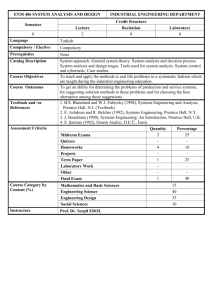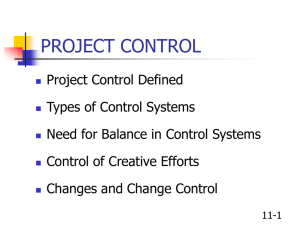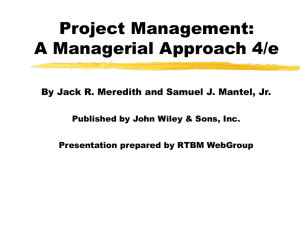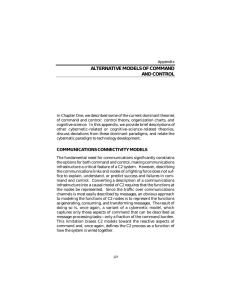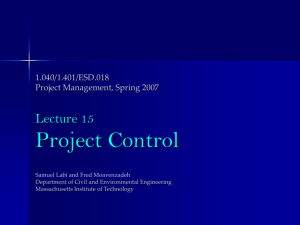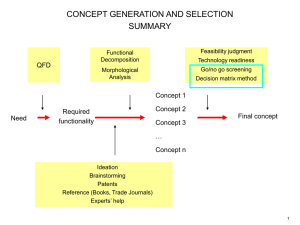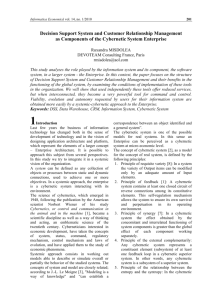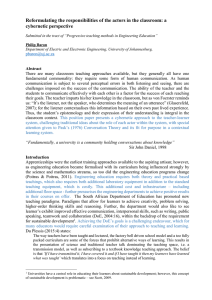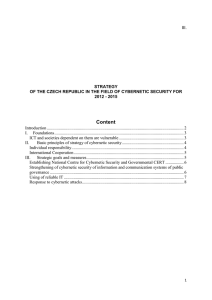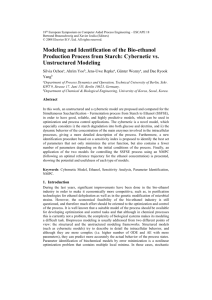unitvii_chapter11presentation1
advertisement
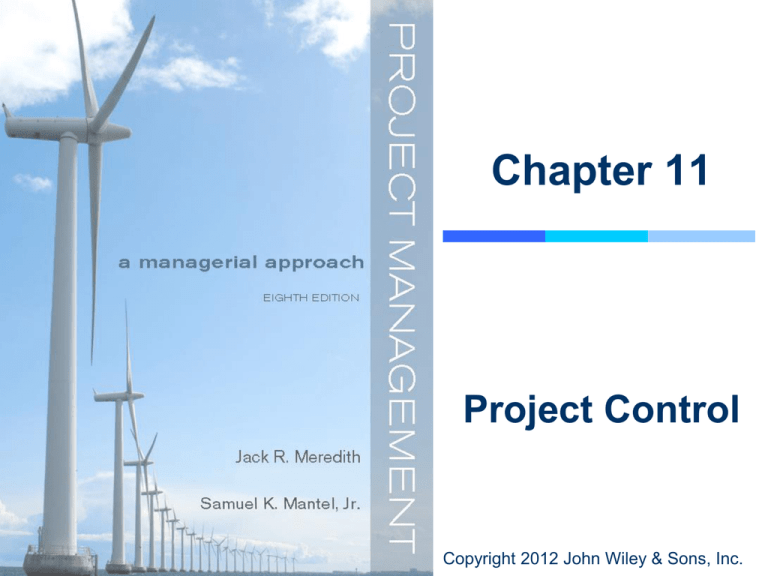
Chapter 11 Project Control Copyright 2012 John Wiley & Sons, Inc. Focus of Control Scope Cost Time 11-2 Scope Technical problems Technical difficulties Quality problems Client wants changes Interfunctional complications Technological breakthroughs Intrateam conflict Market changes 11-3 Cost Difficulties may need more resources Scope may increase Initial bid was too low Reporting was poor Budget was inadequate Correction not on time Input price changed 11-4 Time Difficulties took longer than planned to solve Initial estimates were optimistic Sequencing was incorrect Unavailable resources Preceding tasks were incomplete Change orders Governmental regulations were altered 11-5 The Fundamental Purposes of Control 1. 2. The regulation of results through the alteration of activities The stewardship of organizational assets 11-6 Physical Asset Control Control over the use of physical assets Includes preventive and corrective maintenance Must also control inventory 11-7 Human Resource Control Controlling and maintaining the growth of people People working on projects can gain a wide range of experience Measurement of human resource conservation is difficult Performance appraisals and other measures are not satisfactory devices 11-8 Financial Resource Control Current asset control Project budget Capital investment control Techniques same as those applied to general operation of the firm Context is different because project is accountable to an outsider Must exercise due diligence over resources owned by the client 11-9 Three Types of Control Processes Cybernetic control Go/no-go control Post control 11-10 Cybernetic Control A system that is constantly monitored When a deviation is spotted, corrective action is taken Cybernetic controls are not common in projects Negative feedback loop 11-11 A Cybernetic Control System Figure 11-2 11-12 Information Requirements for Cybernetic Controllers Must have a counteraction for every action Not possible for complex systems 1. 2. 3. 4. 5. Must define what characteristics of an output to control Standards must be set Sensors must be acquired Measurements must be compared to a standard Difference sent to the decision maker 11-13 Go/No-go Controls Testing to see if some preset condition has been met Most of project management is go/no-go controls Use cannot be based on the calendar – – – Some will take place at milestones Some will take place when work packages are completed Others will be on-going 11-14 Go/No-go Controls Continued Data to be collected will match the critical elements of the project plan Actual is compared to what was expected in the plan Regular reports are given to the project manager and senior management 11-15 Phase-Gated Processes Controls the project at various points throughout its life cycle Most commonly used for new product/service development projects Project must pass gate to continue funding 11-16 Postcontrol These are controls that are applied after the fact Their purpose is to mainly improve the performance on future projects Often times, a final report is prepared comparing the plan with reality Sometimes called “lessons learned” 11-17 Postcontrol Report Sections The project objectives Milestones, gates, and budgets The final report on project results Recommendations for performance and process improvement 11-18 The Design of Control Systems Who sets the standards? Are the standards realistic? Are the standards clear? Will they achieve the project goals? What should be monitored? How should they be monitored? Many more… 11-19 Characteristics of a Good Control System Flexible Cost effective Useful Ethical Timely Accurate Simple Easy to maintain Fully documented 11-20 Critical Ratio Control Charts Critical Table 11-1 actual progress ratio schedule progress budgeted cost actual cost 11-21 Benchmarking Promoting the benefits of project management Personnel Methodology Results of project management On-course improvement in project management practices 11-22 Control of Change and Scope Creep Uncertainty about the technology Increase in the knowledge base or sophistication Modification of the rules applying to the project Coping with changes is perceived as the most important problem facing project managers 11-23 Purpose of Formal Change Control System Review all changes Identify all task impacts Translate impacts into scope, cost, and schedule Evaluate the benefits and costs 11-24 Purpose of Formal Change Control System Continued Identify alternative changes Accept or reject Communicate Ensure implementation Report 11-25 Guidelines for an Effective Change Control Procedure Include change process in all agreements Issue a change order for all approved changes Project manager must be consulted Changes must be approved in writing Master plan must be amended 11-26 Control as a Function of Management Control is usually exercised through people Control is exercised when monitoring flags a problem The control may come from any level of management The goal of the control is to get the project back on track 11-27 Human Response to Controls Cybernetic controls – Go/no-go controls – Response tends to be positive Response tends to be neutral or negative Post controls – – See as a report card Response depends on “grade” 11-28 Balance in a Control System Placing too much weight on easy-tomeasure factors Emphasizing shorter-run results at the expense of longer-run objectives Ignoring changes in the environment or goals Overcontrol by the top management “If it is not measured, it is not important” 11-29 Control of Creative Activities Creativity is hard to control Too much control will stifle creativity Three general approaches – – – Process Review Personnel Reassignment Control of Input Resources 11-30 Formal Change Control System Review requests for changes Identify impacts Translate impacts to plan Evaluate cost and benefits Identify alternative changes Accept or reject Communicate Ensure implementation Report 11-31 Change Guidelines All contracts specify how change will be handled Any change requires a change order Project manager must be consulted Must be approved in writing Master plan should reflect changes 11-32
